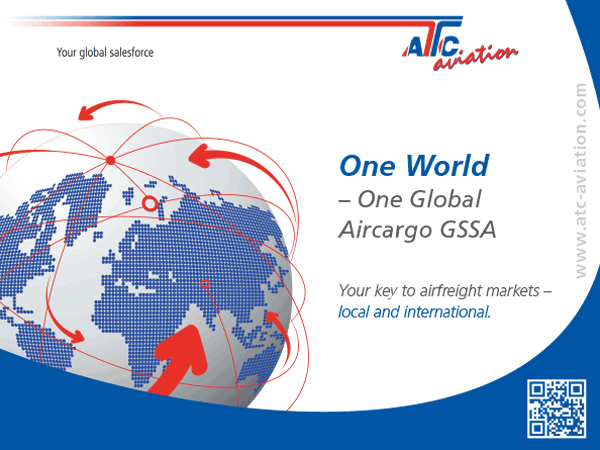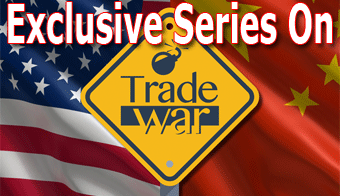
The Sino-U.S.
trade war is casting long shadows over the future prosperity of the
transpacific trade lane, one of the world’s busiest and
most valuable for both air and ocean freight stakeholders.
The earlier tit-for-tat $50bn tariffs
imposed by China and the U.S. on each other’s imports largely
focused on industrial and agricultural products. Although detrimental
to air freight, the damage in terms of retail related products was peripheral.
The latest tranche of U.S. tariffs, however, are decidedly not.
Escalation
Hits Home
The decision by President Trump to instruct
the United States Trade Representative (USTR) to proceed with 10% tariffs
on roughly $200bn of imports from China effective September 24 was a
major escalation of the Sino-U.S. trade war. Moreover, on January 1,
2019, the tariff rate will increase to 25%.
Hey Friend
Do It Again
Should China retaliate, President Trump
also threatened a third tranche of tariffs on approximately $267 billion
of Chinese imports, meaning that tariffs would be applied to most Chinese
products. As Beijing already has responded with retaliatory duties of
$60bn on U.S. imports applicable from September 24 - the tariffs of
5-10% will be applied to 5,207 U.S. products – further escalation
seems certain in the months ahead.
Bimco Bounce
According to shipping organization Bimco,
the first $50bn of U.S. tariffs imposed on China translated into around
660,000 Twenty-Foot Equivalent Units (TEU), about 5.9% of U.S. West
Coast container imports in 2017. A further 22.4 million tonnes of seaborne
containerized goods are expected to be impacted by the latest $200 billion
list, which amounts to a further 20.1% of USWC imports in 2017, or 2.24
million TEU.
Fried Takes
A Peak
 But
how will the new tariffs impact air freight?
But
how will the new tariffs impact air freight?
Brandon Fried, Executive Director at The
Airforwarders Association, said the latest rounds of tariffs could result
in a stronger peak season as shippers bring forward shipments ahead
of the January 1 increase in tariffs to 25%, and the threat of the third
tranche of duties on an additional $267bn more Chinese products.
“I think we’ve already had
a spike in airfreight to a certain extent because some shippers were
bringing in cargo ahead of the $200bn tariffs, and I expect the latest
announcements will see another drive in demand as people look to beat
deadlines,” he told FlyingTypers.
“So the peak will remain strong
in 2018 is my gut reaction. That’s what people are expecting.
There’s too much momentum to have it grind to a halt. That said,
once these tariffs saturate into the economy, we could very well see
an easing in demand and some other adverse impacts.
“It’s really important for
us to remember that the tariffs themselves don’t necessarily just
impact the industry on which they’re focused. There are a lot
of tangential repercussions. They have a ripple effect in other industries
that’s hard to predict at this point.
Fried said that although U.S. efforts
to negotiate a change in Chinese trade policies were broadly welcomed
by domestic air forwarders and traders, the imposition of broad-based
tariffs were not the best means of achieving those ends. “As forwarders
we serve two purposes - we need to give counsel to shippers to make
sure they are using the most efficient modes possible, and we need to
tailor our solutions to what is going to be a big logistical challenge,”
he added.
“But make no mistake about it, there
is going to be an impact regardless of which industry you’re in.”
Seeking
Destinations Unknown
 Speaking
ahead of latest round of tariffs, Li Wenjun, SVP and Head, Air Freight,
DHL Global Forwarding Asia Pacific, told FlyingTypers that
tariffs would impact demand for air and ocean freight services and if
Chinese exports into the U.S. fell there would likely be more volumes
moving into other parts of Asia from China, either for consumption or
for re-export.
Speaking
ahead of latest round of tariffs, Li Wenjun, SVP and Head, Air Freight,
DHL Global Forwarding Asia Pacific, told FlyingTypers that
tariffs would impact demand for air and ocean freight services and if
Chinese exports into the U.S. fell there would likely be more volumes
moving into other parts of Asia from China, either for consumption or
for re-export.
“As China is still the dominant
supplier of many goods that are sold to the U.S., in the short term,
it might be challenging for consumers in the U.S. to find sufficient
substitutes to replace the goods that are currently produced in China,”
he said.
“In the short term, it is unlikely
we will see such relocations [to South East Asia] due to the sourcing
and supply infrastructure necessary to support an efficient manufacturing
environment.”
 Nichols
Counting Pennies
Nichols
Counting Pennies
Gregory Nichols, (right) Asia Principal
at Tradewin, the trade consultant subsidiary of freight forwarder Expeditors,
said shippers should be careful to comply with the new U.S. tariffs
and ensure they verify the U.S. HS Code are accurate. They should also
ensure 'Chinese' goods are actually made in China as defined under U.S.
Rule of Origin accords and look into compliance strategies to reduce
the customs value on which the duty is assessed.
He also warned against trying to avoid
tariffs on Chinese goods by transshipping cargo via third party countries
and, looking ahead, suggested shippers attempt “alternate strategic
sourcing” from alternative countries instead of China.
Evaluating
Risk
 However
sourcing is restructured in Asia, what does seem clear is that the U.S.
economy and consumer will eventually suffer from the Sino-U.S. trade
war. “Every time this trade war escalates, the risk to U.S. consumers
grows,” said Matthew Shay, (right) President and CEO of the National
Retail Federation. “With these latest tariffs, many hardworking
Americans will soon wonder why their shopping bills are higher and their
budgets feel stretched.
However
sourcing is restructured in Asia, what does seem clear is that the U.S.
economy and consumer will eventually suffer from the Sino-U.S. trade
war. “Every time this trade war escalates, the risk to U.S. consumers
grows,” said Matthew Shay, (right) President and CEO of the National
Retail Federation. “With these latest tariffs, many hardworking
Americans will soon wonder why their shopping bills are higher and their
budgets feel stretched.
“We cannot afford further escalation,
especially with the holiday shopping season right around the corner.
The mere talk of tariffs on all remaining Chinese imports is of serious
concern to retailers since tariffs of that magnitude would touch every
aspect of American life.
“Achieving better trade deals is
an important priority, but there is nothing better about it when American
families are forced to pay higher prices for everyday purchases.”
SkyKing







 Vol.
17 No. 62
Vol.
17 No. 62 Vol.
17 No. 63
Vol.
17 No. 63

 Virgin
Atlantic Cargo jumped 3% during the first half of 2018, but Dominic
Kennedy, (right) Managing Director is taking nothing for granted.
Virgin
Atlantic Cargo jumped 3% during the first half of 2018, but Dominic
Kennedy, (right) Managing Director is taking nothing for granted. Taking
A Step Further
Taking
A Step Further
 Virgin
Atlantic founder Richard Branson and Actor Ryan Reynolds have formed
a partnership between Virgin Atlantic and Aviation American Gin, which
is owned by Reynolds, that will see the airline take the spirit of
Aviation Gin to new heights.
Virgin
Atlantic founder Richard Branson and Actor Ryan Reynolds have formed
a partnership between Virgin Atlantic and Aviation American Gin, which
is owned by Reynolds, that will see the airline take the spirit of
Aviation Gin to new heights.
 But
how will the new tariffs impact air freight?
But
how will the new tariffs impact air freight?  Speaking
ahead of latest round of tariffs, Li Wenjun, SVP and Head, Air Freight,
DHL Global Forwarding Asia Pacific, told FlyingTypers that
tariffs would impact demand for air and ocean freight services and if
Chinese exports into the U.S. fell there would likely be more volumes
moving into other parts of Asia from China, either for consumption or
for re-export.
Speaking
ahead of latest round of tariffs, Li Wenjun, SVP and Head, Air Freight,
DHL Global Forwarding Asia Pacific, told FlyingTypers that
tariffs would impact demand for air and ocean freight services and if
Chinese exports into the U.S. fell there would likely be more volumes
moving into other parts of Asia from China, either for consumption or
for re-export. Nichols
Counting Pennies
Nichols
Counting Pennies  However
sourcing is restructured in Asia, what does seem clear is that the U.S.
economy and consumer will eventually suffer from the Sino-U.S. trade
war. “Every time this trade war escalates, the risk to U.S. consumers
grows,” said Matthew Shay, (right) President and CEO of the National
Retail Federation. “With these latest tariffs, many hardworking
Americans will soon wonder why their shopping bills are higher and their
budgets feel stretched.
However
sourcing is restructured in Asia, what does seem clear is that the U.S.
economy and consumer will eventually suffer from the Sino-U.S. trade
war. “Every time this trade war escalates, the risk to U.S. consumers
grows,” said Matthew Shay, (right) President and CEO of the National
Retail Federation. “With these latest tariffs, many hardworking
Americans will soon wonder why their shopping bills are higher and their
budgets feel stretched.

 Air
Cargo News FlyingTypers reserves the right to edit all submissions
for length and content. All photos and written material submitted to
this publication become the property of All Cargo Media.
Air
Cargo News FlyingTypers reserves the right to edit all submissions
for length and content. All photos and written material submitted to
this publication become the property of All Cargo Media.